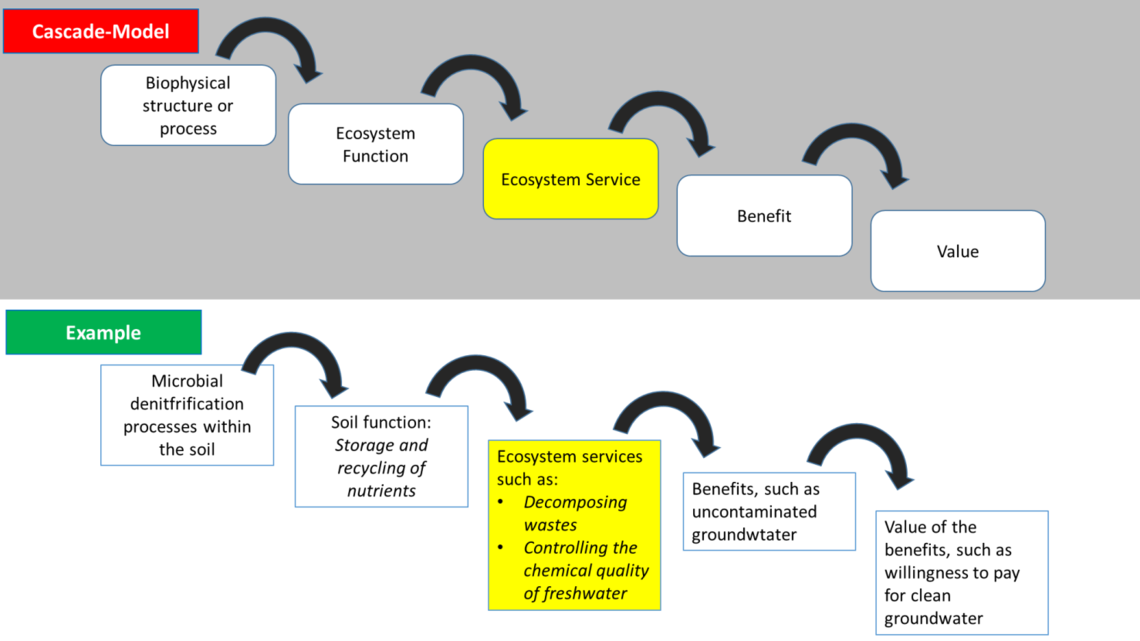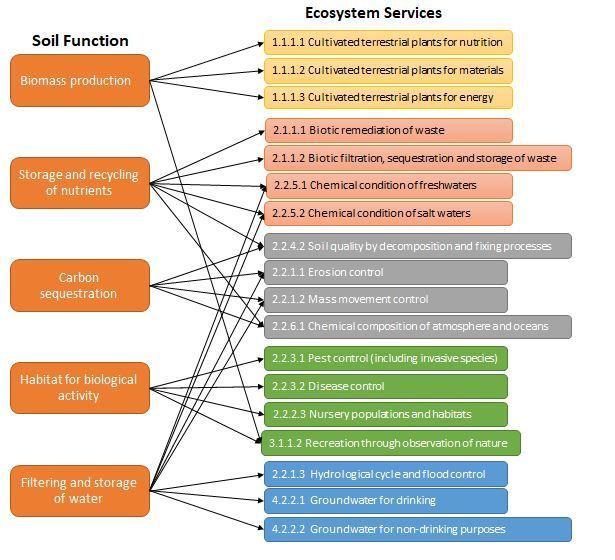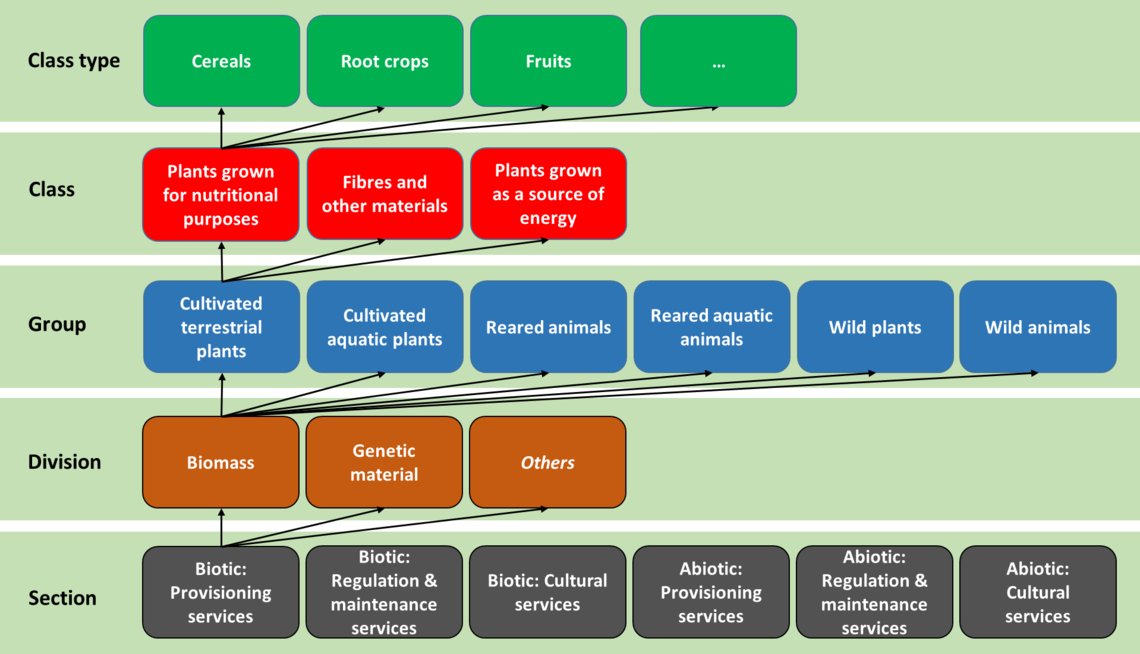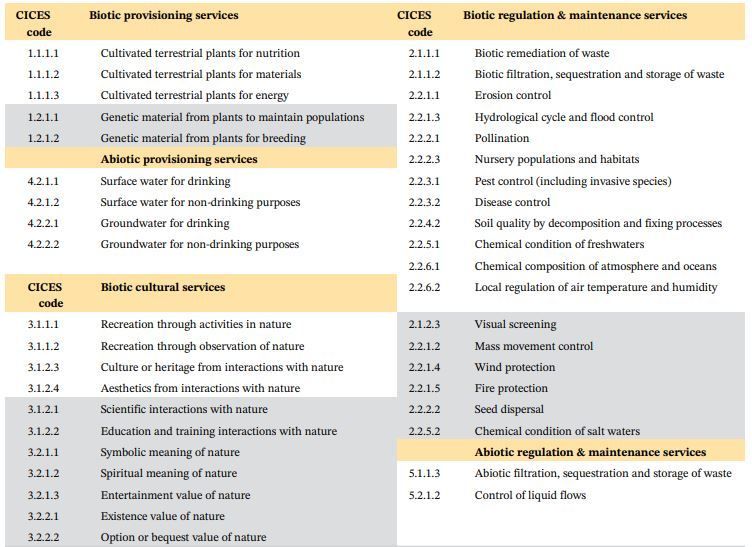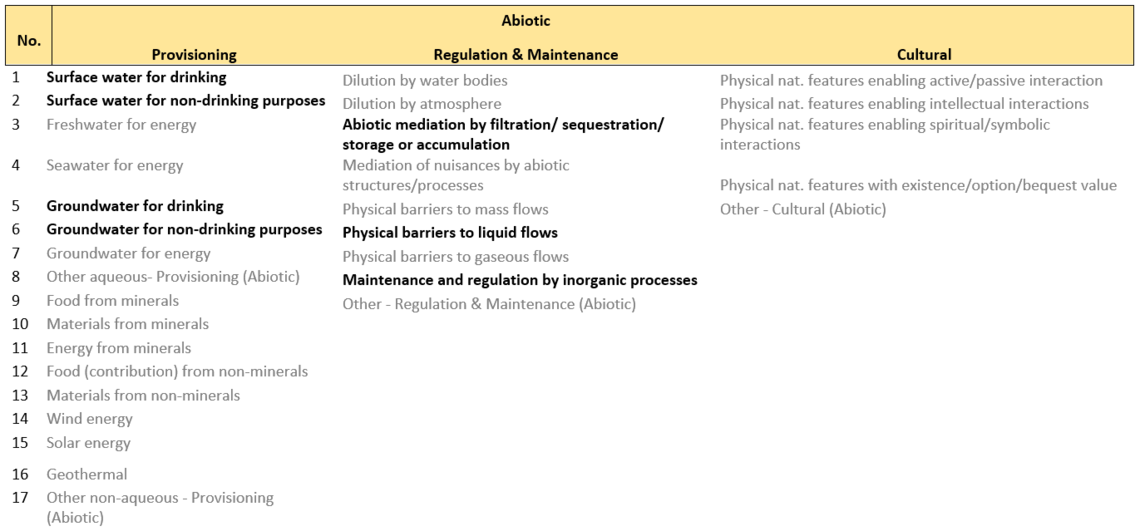Ecosystem Services
The concept of ecosystem services aims at demonstrating the value of ecosystems for human societies. Multiple ecosystem services are based on soils. They are particularly relevant for targets of a sustainable bioeconomy and for the internationally agreed Sustainable Development Goals (SDG). However, the operationalisation of linkages between soil management, soil functions and ecosystem services remains a challenge. The BonaRes Assessment Platform addresses this by supporting impact assessments from the perspective of soil related ecosystem services. It provides methods for designing assessments and offers guidance for selecting, applying and linking indicators related to ecosystems services.
The concept of ecosystem services aims at demonstrating the value of nature for human societies (Costanza et al., 1997, 2017; MEA, 2005; Haines-Young & Potschin, 2013; Potschin-Young et al., 2017; TEEB 2010). Ecosystem services can be seen as arising from the interaction of biotic and abiotic processes, and refer specifically to the ‘final’ outputs of ecological systems, i.e., the goods and services directly consumed or used by people (Haines-Young & Potschin, 2013; Potschin-Young et al., 2017). According to the cascade model, first introduced by Haines-Young & Potschin (2010), ecosystem services are based on biophysical structures or processes and the functions they serve. From ecosystem services humans generate benefits and values. Figure 9 shows the full cascade, starting from a biophysical structure or process and leading to values for humans. Additionally, the figure provides a soil related example.
Figure 9: Ecosystem service cascade model and example for a soil related cascade. Own representation based on Potschin & Haines-Young (2011)
Defining which ecosystem services are provided by soils or to what degree soils contribute to specific ecosystem services is almost impossible, because most services are generated by the interaction of multiple ecosystem components. For example, soils allow cereals like wheat to grow and to produce food for humans. However, the wheat plant itself is not part of the soil, and neither are rainfall, sunlight or human inputs such as seedbed preparation and sowing. Only the combination of these factors creates the ecosystem service “provision of food”. For this reason, it is more practical to refer to soil related ecosystem services. In the context impact assessments, we consider those ecosystem services to be soil related that are either based exclusively on soil functions, or where soil functions make a significant contribution to the final service. An example for services from the first category is the purification of water during its passage through the soil matrix, examples for services from the second category are the aboveground habitats created by plants growing in the soil. Both types of soil related ecosystem services have in common that they are affected by agricultural management.
The role of soils within the ecosystem services concept has been addressed in a number of recent publications (Stavi et al., 2016; Schwilch et al., 2016; Keesstra et al., 2016; Baveye et al., 2016; Adhikari & Hartemink, 2016; Helming et al., 2018) supplementing earlier studies on distinct aspects of soil functions and soil related ecosystem services (Blum, 1993; Daily et al., 1997; Robinson et al., 2009; Dominati et al., 2010; Bennett et al., 2010; Breure et al., 2012; Pulleman et al., 2012; Bouma, 2014; Schulte et al., 2014). The following figure illustrates how different categories of soil related ecosystem services are based on soil functions.
Figure 10: Connection between soil functions and selected soil related ecosystem services. Please note that all soil function are connected to and influencing each other.
The concept of ecosystem services has been proven very useful in policy support to demonstrate and assess human-environment interactions (Helming et al., 2013). Soil related ecosystem services are fundamental to achieving targets of a sustainable bioeconomy and of the internationally agreed Sustainable Development Goals (SDG (General Assembly, 2015). For agricultural soils, management determines the degree by which different services are provided. No management exists that can maximize all ecosystem services at the same time. Farmers must make decisions on trade-offs between different services, wherein trade-offs between provisioning services (such as provision of food, feed and fibre) and regulating and maintenance services (such as provision of habitats or chemical quality of freshwaters) are the most typical. For example, intensive management with high applications of fertilizers and pesticides will maximize yields and the ecosystem service: provision of food. On the other hand, the ecosystem service: provision of habitats for insects and birds will be reduced and the ecosystem service: chemical quality of freshwaters (groundwater or rivers) may be compromised by seepage.
Impact assessments need to account for the fact that agricultural management always implies trade-offs between different ecosystem services. Each management option will enhance the provision of some ecosystem services while reducing the provision of others. Where impact assessments only consider a selected number of services, this selection may therefore already determine the assessment results. Depending on which ecosystem services are considered, assessments will find different policy options to have the most positive impacts. Sound research design is required to safeguard against such arbitrariness and potential for manipulation (see section on Impact Area Selection), and to instead highlight the trade-offs between options.
For the assessment of ecosystem services, the BonaRes Assessment Platform uses the Common International Classification of Ecosystem Services (CICES) (Haines-Young & Potschin, 2018) which provides a complete and standardized classification scheme designed to support accounting of ecosystem services. It was developed in collaboration with the European Environment Agency (EEA) and builds on earlier classifications as part of The Economics of Ecosystems and Biodiversity (TEEB, 2010) and the Millennium Ecosystem Assessment (MEA, 2005). CICES makes a substantial contribution to a standardisation of ecosystem service assessments and links up with efforts to integrate ecosystem services into national and European accounting systems (Edens and Hein, 2013).
CICES has a strictly hierarchical, five-level structure, organized from bottom to top into: section, division, group, class and class type. Three sections provided by the biotic components of ecosystems are distinguished: Provisioning, Regulation & Maintenance and Cultural. In an extension introduced in 2018 with CICES version 5.1, abiotic sections for Provisioning, Regulation & Maintenance and Cultural services were added. Figure 11 shows how the production of cereals as food crops fits into the CICES hierarchy.
Figure 11: CICES 5.1 hierarchy from section to class type: Example of cereals produced as food crops.
The hierarchical structure is intended to facilitate ecosystem service accounting at different spatial scales. The BonaRes Assessment Platform supports assessments at the class level, because the higher hierarchical levels lack the detail usually required for meaningful investigations into the effects of agricultural management. However, where data availability is insufficient, users are encouraged to move to group level for individual categories. An example of such a strategy is provided by Maes et al. (2016).
In total, there are 84 ecosystem service classes in CICES. In a preliminary assessment conducted by the author, half of them (42) were considered to be related to agricultural soils and their management (Tables 2 and 3). These service classes are mainly from the biotic regulating and maintenance section. In the context of the BonaRes assessment platform, soil related ecosystem service classes are considered potential impact areas. For each of them, a description, lists of indicators, information on strength and weaknesses associated with their measurement, and references to examples in published research are provided. Additionally, the platform offers guidelines for selecting impact areas suited to requirements of specific assessment. Though multiple correlations exist between ecosystem services, these correlations are very difficult to account for in the design of measurements. Published studies generally assess ecosystem services individually and only address correlations between them as part of their results and discussion. This approach is also followed in the methods presented on the BonaRes Assessment Platform.
The CICES classes are not an ideal fit for the context of soil related impact assessments. Some classes are very broad (e.g., maintaining soil organic matter and nutrients), some are very specific (e.g., biomass for food & feed, biomass for material use, biomass for energy) some overlap (e.g., bio-remediation of wastes, maintaining soil organic matter and nutrients, chemical regulation of freshwaters) and some important soil physical categories such as aggregate stability or resistance against compression are not accounted for. However, CICES offers a comprehensive standard for ecosystem services assessment, thereby increasing policy relevance and comparability of study results. In spite of these shortcomings in the current CICES version, the BonaRes Assessment Platform therefore builds on the CICES classification and aims at facilitating its use in soil related assessments.
As is the case for all assessment perspectives, the ecosystem services concept only addresses a limited set of societal targets while ignoring targets from other valuation systems, such as resource use efficiency, equity or health (Sandifer et al., 2015; Schröter et al., 2017, Helming et al., 2018). Using more than one perspective will provide a more comprehensive picture of (potential) impacts. Though still uncommon, a number of soil related studies have recently shown how linkages to other valuation systems are possible, e.g., as outlined by Bouma (2014) and Keesstra et al. (2016). For this reason, the BonaRes Assessment Platform also supports the two complementary perspectives of Ecosystem Services and Resource Use Efficiency and encourages researchers to use them both.
Table 2: Soil management-related ecosystem services. Twenty-five services are typically affected by agricultural soil management (white background) and comprise a short list that should be considered in any impact assessment of soil management. Fifteen services (grey background) are only relevant within specific contexts (e.g., geographic peculiarities or special land uses). Common International Classification of Ecosystem Services (CICES) class names were simplified to aid intuitive understanding.
Table 3: CICES V5.1 (Common International Classification of Ecosystem Services) abiotic ecosystem service classes. Class names were simplified by us to allow for a better overview. Classes considered relevant for the assessment of soil management and soil functions changes are marked in black.
Adhikari K, Hartemink A E. 2016. Linking soils to ecosystem services — A global review. Geoderma 262: 101–111. DOI:10.1016/j.geoderma.2015.08.009
Bennett L T, Mele P M, Annett S, Kasel S. 2010. Examining links between soil management, soil health, and public benefits in agricultural landscapes: An Australian perspective. Agriculture, Ecosystems & Environment 139: 1–12. DOI:10.1016/j.agee.2010.06.017
Blum W E H. 1993. Soil Protection Concept of The Council of Europe and Integrated Soil Research. In Integrated Soil and Sediment Research: A Basis for Proper Protection: Selected Proceedings of the First European Conference on Integrated Research for Soil and Sediment Protection and Remediation (EUROSOL), Eijsackers H J P, Hamers T (eds). Springer Netherlands: Dordrecht, 37–47.
Bouma J. 2014. Soil science contributions towards Sustainable Development Goals and their implementation: linking soil functions with ecosystem services. Journal of Plant Nutrition and Soil Science 177: 111–120. DOI:10.1002/jpln.201300646
Breure A M, De Deyn G B, Dominati E, Eglin T, Hedlund K, Van Orshoven J, Posthuma L. 2012. Ecosystem services: a useful concept for soil policy making! Current Opinion in Environmental Sustainability 4: 578–585. DOI:10.1016/j.cosust.2012.10.010
Costanza R, d'Arge R, de Groot R, Faber S, Grasso M, Hannon B, Limburg K, Naeem S, O'Neill R, Paruelo J, Raskin R, Sutton P, van den Belt M. 1997. The value of the world's ecosystem services and natural capital. Nature 387 (6630): 253–260.
Daily G C, Matson P A, Vitousek, P M. 1997. Ecosystem services supplied by soil. In: Daily G C (ed.) Nature’s Services: Societal Dependence on Natural Ecosystems. Island Press, Washington, D.C., U.S.A., 113–132.
Dominati E, Patterson M, Mackay A. 2010. A framework for classifying and quantifying the natural capital and ecosystem services of soils. Ecological Economics 69: 1858-1868. DOI:10.1016/j.ecolecon.2010.05.002
Edens B, Hein L. 2013. Towards a consistent approach for ecosystem accounting. Ecological Economics 90: 41–52. DOI:10.1016/j.ecolecon.2013.03.003
General Assembly. 2015. Transforming our world: the 2030 Agenda for Sustainable Development, A/RES/70/1. Online: https://bit.ly/29kJaEI (accessed 09 August 2019).
Haines-Young R, Potschin M B. 2010. The Links Between Biodiversity, Ecosystem Services and Human Well-Being. In: Raffaelli D, Frid C (eds.) Ecosystem Ecology: A New Synthesis. Ecological Reviews, Cambridge University Press, Cambridge, United Kingdom, 110–139. DOI:10.1017/CBO9780511750458.007
Haines-Young R, Potschin M B. (2018): Common International Classification of Ecosystem Services (CICES) V5.1 and Guidance on the Application of the Revised Structure. Available from www.cices.eu
Helming, K., K. Diehl, D. Geneletti, H. Wiggering. 2013. Mainstreaming ecosystem services in European policy impact assessment. Environmental Impact Assessment Review 40:82-87.
Helming K, Daedlow K, Paul C, Techen A, Bartke S, Bartkowski B, Kaiser DB, Wollschläger U, Vogel HJ. 2018. Managing soil functions for a sustainable bioeconomy – Assessment framework and state of the art. Land Degradation & Development 29:3112-3126. DOI:10.1002/ldr.3066
Keesstra S D, Bouma J, Wallinga J, Tittonell P, Smith P, Cerdà A, Montanarella L, Quinton JN, Pachepsky Y, van der Putten W H, Bardgett R D, Moolenaar S, Mol G, Jansen B, Fresco L O. 2016. The significance of soils and soil science towards realization of the United Nations Sustainable Development Goals. SOIL 2: 111–128. DOI:10.5194/soil-2-111-2016
Maes J, Liquete C, Teller A, Erhard M, Paracchini M L, Barredo J I, Grizzetti B, Cardoso A, Somma F, Petersen J E, Meiner A, Gelabert E R, Zal N, Kristensen P, Bastrup-Birk A, Biala K, Piroddi C, Egoh B, Degeorges P, Fiorina C, Santos-Martin F, Narusevicius V, Verboven J, Pereira H M, Bengtsson J, Gocheva K, Marta-Pedroso C, Snall T, Estreguil C, San-Miguel-Ayanz J, Perez-Soba M, Gret-Regamey A, Lillebo A I, Malak D A, Conde S, Moen J, Czucz B, Drakou E G, Zulian G, Lavalle C (2016) An indicator framework for assessing ecosystem services in support of the EU Biodiversity Strategy to 2020. Ecosystem Services, 17, 14–23. DOI:10.1016/j.ecoser.2015.10.023 .
MEA (Millennium Ecosystem Assessment). 2005. Ecosystems and Human Well-being: Synthesis. Island Press: Washington, DC.
Ministère de l'Agriculture de l'Agroalimentaire et de la Forêt. 2015/2016. 4 pour 1000. Online: http://4p1000.org (accessed 09 August 2019)
Potschin-Young M, Haines-Young R, Görg C, Heink U, Jax K, Schleyer C. 2017. Understanding the role of conceptual frameworks: Reading the ecosystem service cascade. Ecosystem Services. DOI:10.1016/j.ecoser.2017.05.015
Potschin-Young M, Haines-Young R, Görg C, Heink U, Jax K, Schleyer C. 2017. Understanding the role of conceptual frameworks: Reading the ecosystem service cascade. Ecosystem Services. DOI:http://dx.doi.org/10.1016/j.ecoser.2017.05.015
Pulleman M, Creamer R, Hamer U, Helder J, Pelosi C, Pérès G, Rutgers M. 2012. Soil biodiversity, biological indicators and soil ecosystem services—an overview of European approaches. Current Opinion in Environmental Sustainability 4: 529–538. DOI:10.1016/j.cosust.2012.10.009
Robinson D A, Lebron I, Vereecken H. 2009. On the Definition of the Natural Capital of Soils: A Framework for Description, Evaluation, and Monitoring. Soil Science Society of America Journal 73: 1904–1911. DOI:10.2136/sssaj2008.0332
Sandifer P A, Sutton-Grier A E, Ward B P. 2015. Exploring connections among nature, biodiversity, ecosystem services, and human health and well-being: Opportunities to enhance health and biodiversity conservation. Ecosystem Services 12: 1–15. DOI:10.1016/j.ecoser.2014.12.007
Schröter M, Stumpf K H, Loos J, van Oudenhoven A P E, Böhnke-Henrichs A, Abson D J. 2017. Refocusing ecosystem services towards sustainability. Ecosystem Services 25: 35–43. DOI:10.1016/j.ecoser.2017.03.019
Schulte R P O, Creamer R E, Donnellan T, Farrelly N, Fealy R, O’Donoghue C, O’hUallachain D. 2014. Functional land management: A framework for managing soil-based ecosystem services for the sustainable intensification of agriculture. Environmental Science & Policy 38: 45–58. DOI:10.1016/j.envsci.2013.10.002
Schwilch G, Bernet L, Fleskens L, Giannakis E, Leventon J, Marañón T, Mills J, Short C, Stolte J, van Delden H, Verzandvoort S. 2016. Operationalizing ecosystem services for the mitigation of soil threats: A proposed framework. Ecological Indicators 67: 586–597. DOI:10.1016/j.ecolind.2016.03.016
Stavi I, Bel G, Zaady E. 2016. Soil functions and ecosystem services in conventional, conservation, and integrated agricultural systems. A review. Agronomy for Sustainable Development 36: 32. DOI:10.1007/s13593-016-0368-8
TEEB (The Economics of Ecosystems and Biodiversity). 2010. Mainstreaming the Economics of Nature: A Synthesis of the Approach, Conclusions and Recommendations of TEEB. Online: https://bit.ly/1UkiSrI (accessed 09 August 2019)

